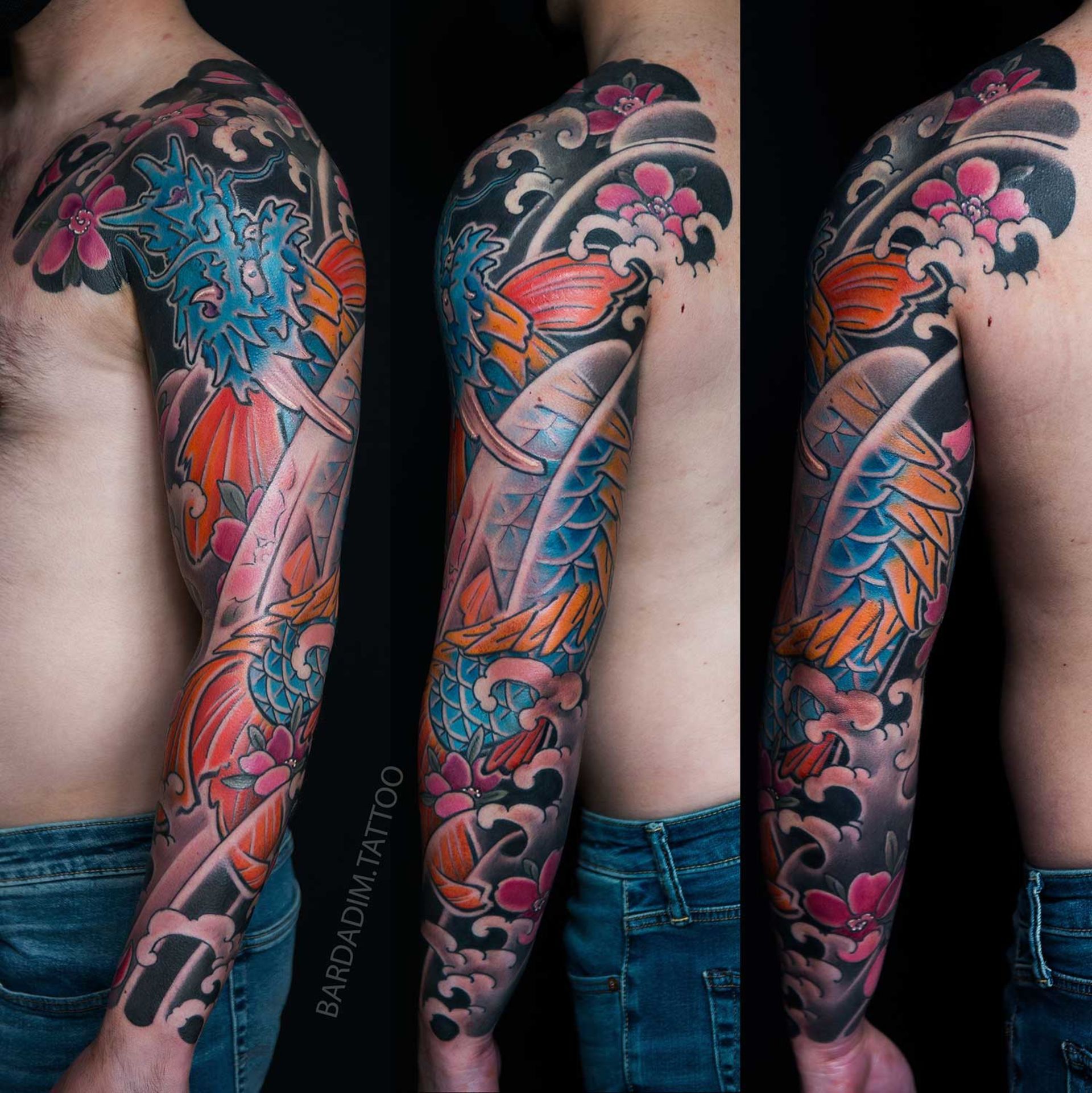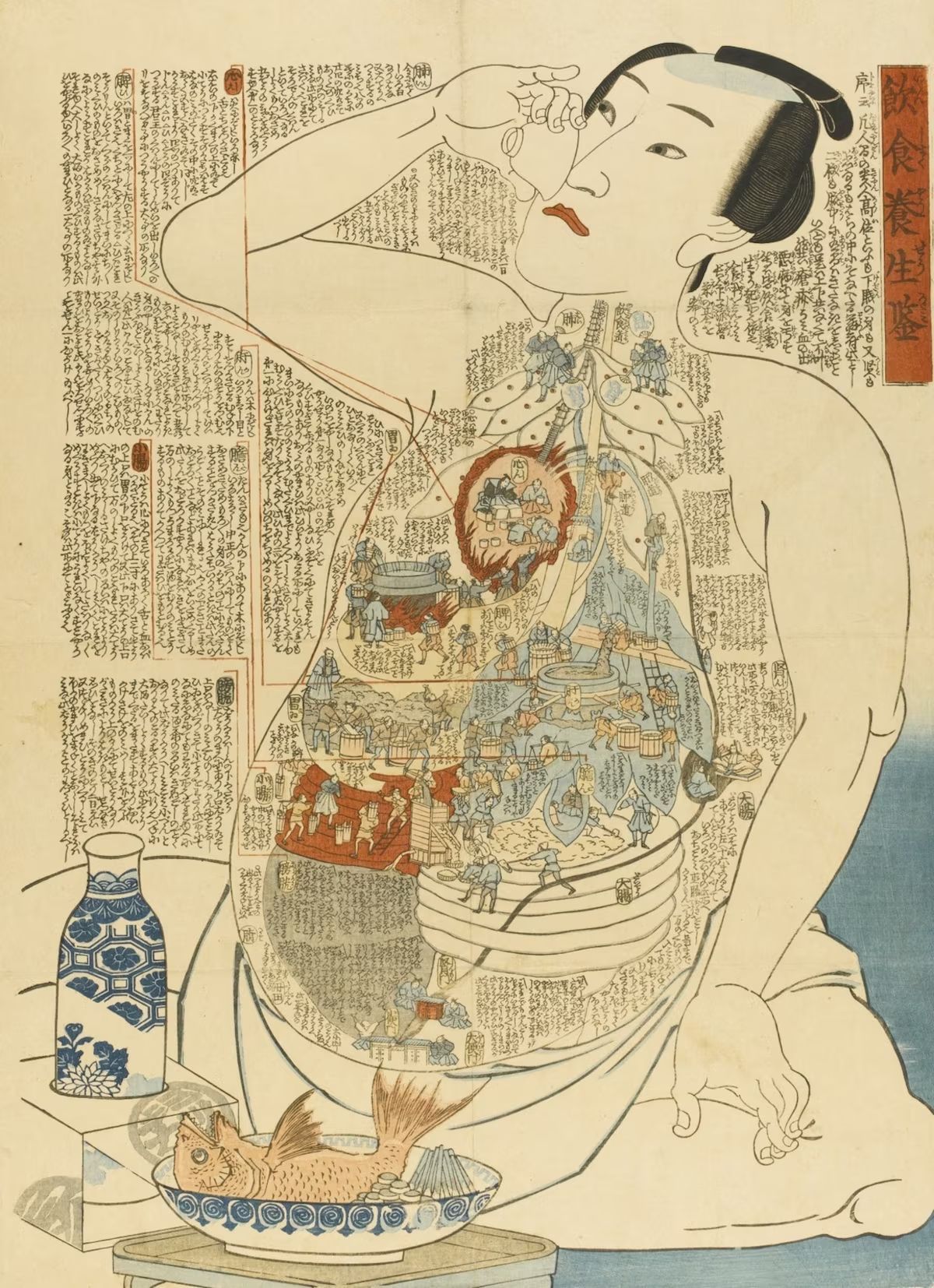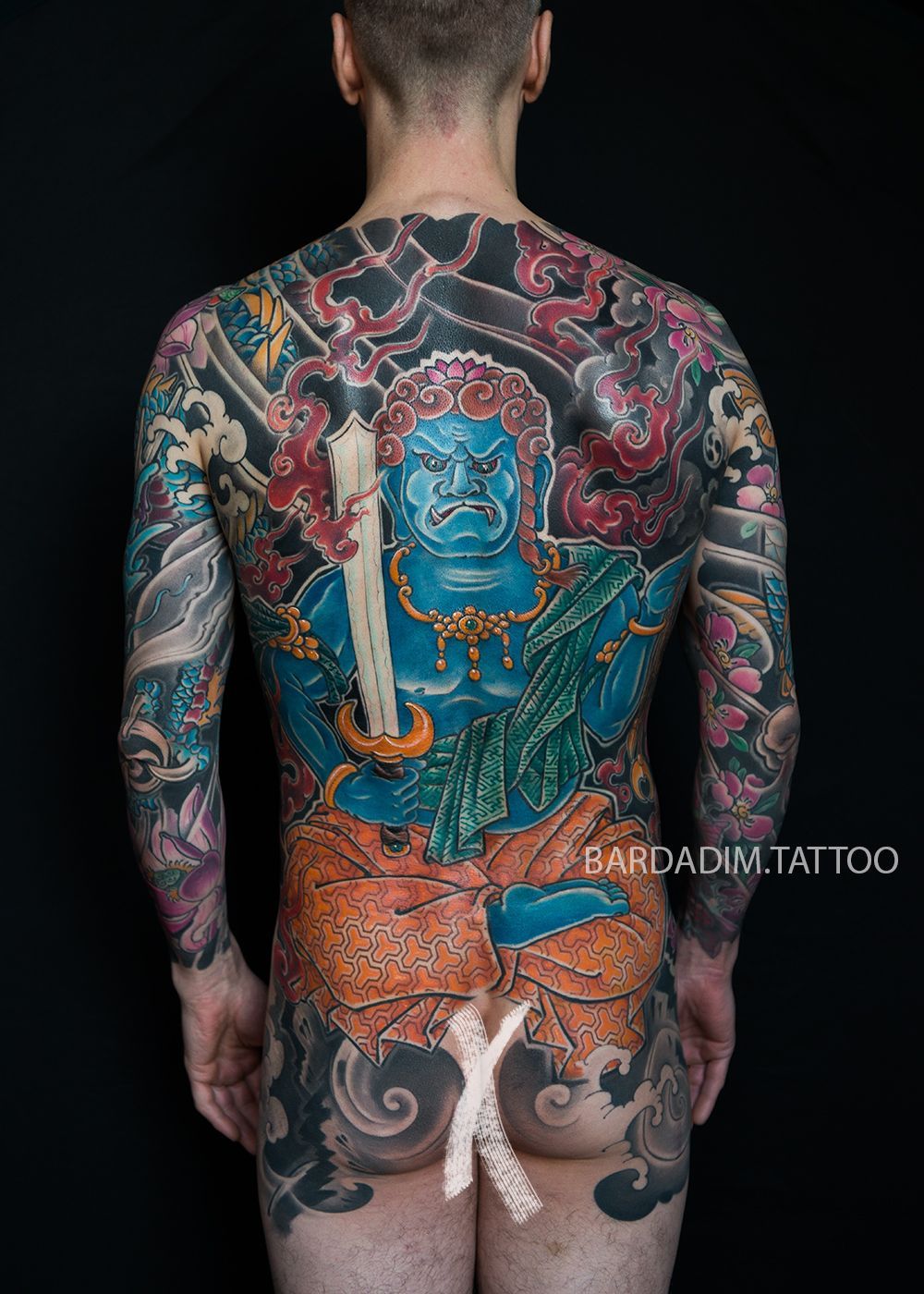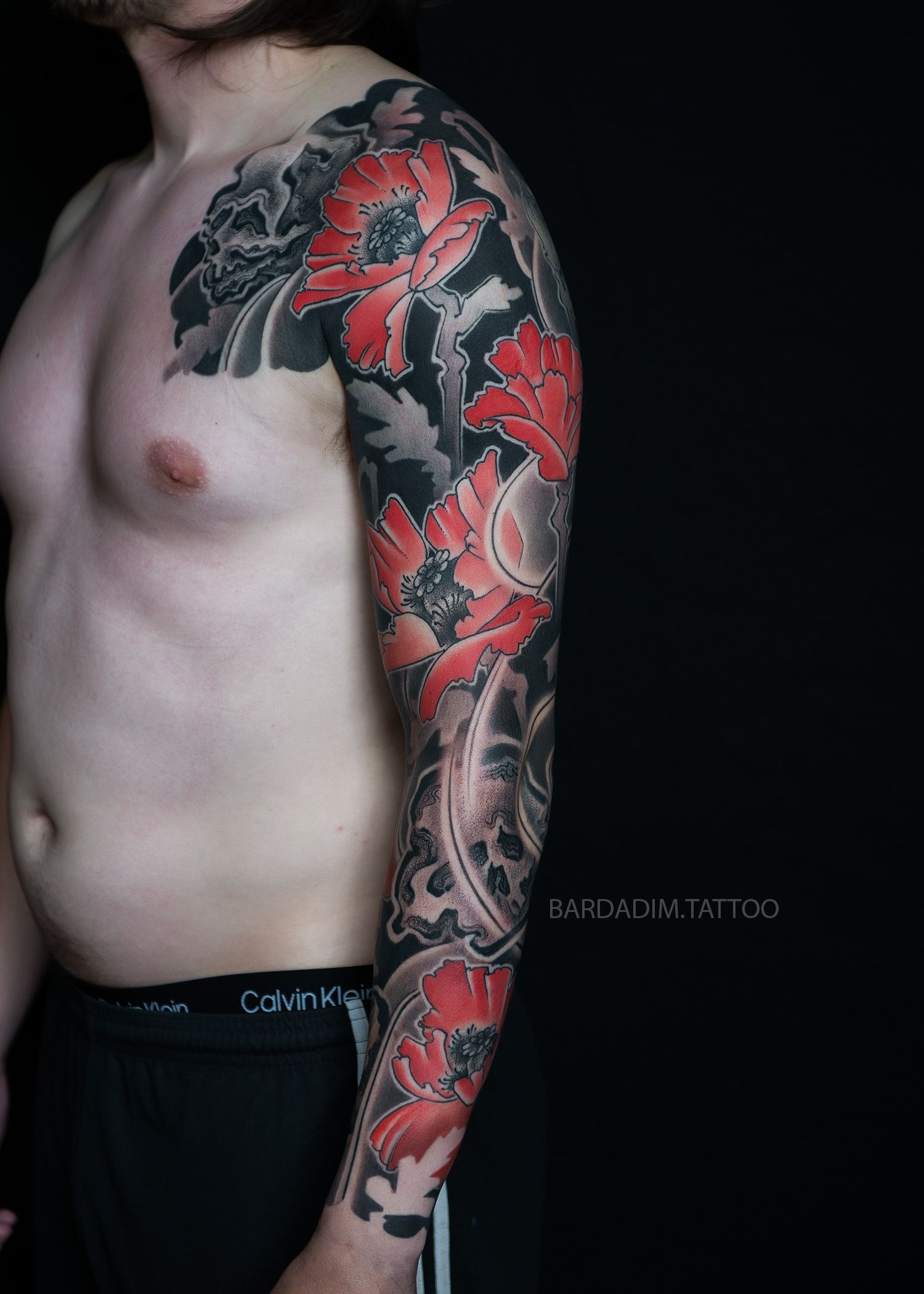
Japanese Koi Sleeve Tattoo is finished today at Southmain.tattoo, Doylestown. This Full Sleeve done in Japanese Tattoo style and shows blue koi fish and hannya mask surrounded with peony flowers.
TATTOOS IN MODERN JAPAN ( by Irezumi Art UK )
At the beginning of the Meiji “1869″ period the Japanese government, wanting to raise its image and make a good impression on the West, outlawed tattoos, and Irezumi took on connotations of criminality. Nevertheless, fascinated foreigners went to Japan seeking the skills of tattoo artists, and traditional tattooing continued underground. There is a story that the British monarch, King Edward VII had a Japanese tattooist brought to him and had dragons put on his fore arms and then sent the tattooer to New England to have his friends in America tattooed by him as well, as a gift of good will & friendship.
Tattooing was legalized by the occupation forces in 1945, but has retained its image of criminality. For many years, traditional Japanese tattoos were associated with the Yakuza, Japan’s notorious Mafia, and many businesses in Japan (such as public baths, fitness centres and hot springs) still ban customers with tattoos.
Traditional Irezumi (an art form in itself) is still done by specialized tattooists, it is painful, very time-consuming and expensive : a typical traditional body suit (Vest or jacket, long or Short Sleeves, Long or Short Pants, and traditionally leaving an un-tattooed space down the centre of the body) can take, on average, one to five years of weekly visits to complete, showing that the person with heavy Irezumi will finish what he or she starts and can be very respected for it, and the imagery that is in a persons Irezumi can be viewed to see the aspirations of that individual.
KOI (CARP)
Probably surprising to many westerners is the very large amount of ancient myths that surround these beautiful fish in the orient, and their elevated status there. The koi is more than just a colourful and collectible fish, it is also one of the most popular and beautiful story, myth, tale and tattoo themes, a beauty which belies its symbolic meaning. Although Chinese in origin, the koi is now widely celebrated in Japan, particularly for its masculine qualities. It is said to climb waterfalls bravely, and, if caught it will lie upon the cutting board awaiting the knife without a quiver, not unlike the warrior facing the sword.
Eventually, the stoic fish came to be associated with so many masculine and positive qualities that it was appropriated for the annual “Boys day festival” in Japan where even today colourful, streaming koi flags are traditionally displayed for each son in the family. In tattoo imagery, especially in combination with flowing water, it symbolizes much the same courage, control, and the ability to achieve goals with an understanding of life’s trials”.
BOTAN (PEONY)
The Peony is considered the best of flowers and is known as the King of flowers. In short it means elegance and wealth. With it’s large and spreading petals, which are delicately curled at the edges, the peony has been called “the rose without thorns”. Although often depicted in tattoo imagery in deep red, it is today also cultivated in many other colours.
In the ornate, complex, and extensive body coverage that is typically involved in Japanese tattoos, it may seem as though entire gardens appear, but the floral repertoire of traditional Japanese tattoo is not as extensive as it might first appear, among the select flowers that are used is the peony, it is regarded as a symbol of wealth, good fortune and prosperity. In addition though, it also suggests a sort of gambling, daring and even a masculine devil-may-care attitude, quite unlike its character in the west.
HANNYA
The hannya mask is just one example of the many different types of masks used by the traditional Japanese actors of Noh theatre. Noh performances are very stylized representations of traditional and well known stories, developed in Japan during the 14th century. The masks are used to convey the identity and mood of the various characters, who number nearly eighty in the different tales. The hannya mask is specifically used to represent a vengeful and jealous woman. Her anger and envy have so consumed her that she has turned into a demon, but with some important traces of humanity left. The pointed horns, gleaming eyes, fang-like teeth, combined with a look of pure resentment and hate are tempered by the expression of suffering around the eyes and the artfully disarrayed strands of hair, which indicate passionate emotion thrown into disorder. The deeper and more extreme the colouring of the face, the deeper and more extreme run the emotions of the character. Tattooing takes full advantage of these fanciful and engaging images, often using them in larger pieces of Japanese work or sometimes juxtaposing masks of good and evil characters. Often a Noh mask will also appear in isolation, as a work of art unto itself, not unlike the actual masks which are highly prized and very collectible. Even to this day, in Japan, a hand gesture of two index fingers sticking up from a man’s forehead is an indication that his wife is mad at him or jealous. A more reddish colour indicates strong resentment and anger and is used in such plays as Dodoji and Kurozuka, whereas a paler colour would be more appropriate for Aoi-no-ue. Dodoji is the story of unrequited love between a woman and a priest of Dodoji (temple). She turns into a demonic serpent who wraps her body around the temple bell consuming it and the priest in the process. If the teeth of a hannya are blackened in, it is to show that she would want “not” to look beautiful to anybody but her deepest love, meaning absolute targeted emotions.
There is often double meaning to all the Japanese myths. Let’s remember the role of anger! It can often be caused by despair! Long life to understanding and compassion.
All Tattoo Projects

Other Posts



Ready to start your tattoo project?
We do NOT do walk-ins. ONLY private appointments which really easy to schedule. Please learn the process and request your consultation.



